A Fragile Illusion
Iconoclasm in Igor and Gleb Aleynikov’s The Revolutionary Sketch (Revolutsionii Etiud, 1987)
Vol. 109 (November 2020) by Oliver Banatvala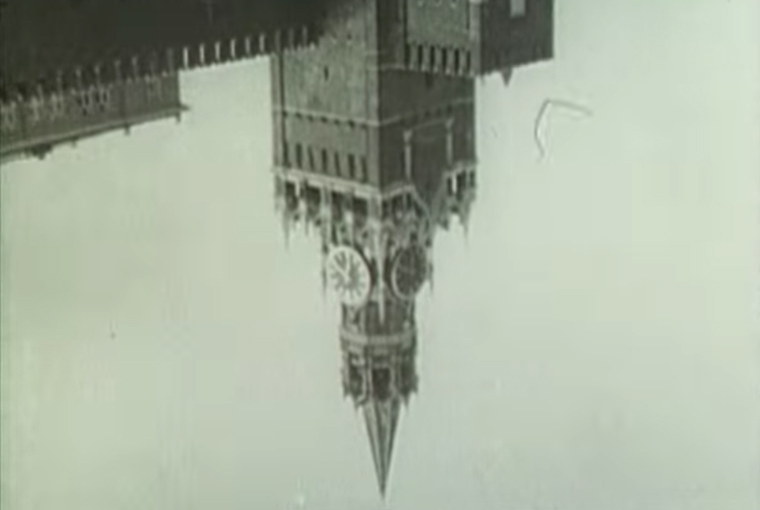
The Revolutionary Sketch is a seven-and-a-half-minute audio and visual collage. The soundtrack mixes fanfares, songs of the Young Pioneers, and official state announcements, which are occasionally manipulated – sped up or warped. Visually, black and white newsreel is combined with cutout animation and clips of young people – presumably the directors and their friends – messing around. The result is a fragmented and non-linear piece, which provides a somewhat disorientating experience to the viewer.
Upon closer inspection, however, the video shows itself to be a highly subversive critique of Soviet state power, fitting neatly into the wider stance of Soviet Parallel Cinema, which defined itself in opposition to official Soviet culture. In the words of Igor Aleynikov, one of the founders of the movement, Soviet Parallel Cinema was “created outside the system of state cinematic production…as a counter-balance to the state monopoly on the means of cinematic production”.1
One of the most prominent manifestations of state power was official discourse. Through its symbiotic relationship with the Soviet state, it achieved a unique status as a key element of the preservation of power. It was a ubiquitous language which had infused daily life, a central pillar of Soviet society. Indeed, its total infiltration into the everyday is reflected in the very existence of a “state monopoly on the means of cinematic production”.2
Martin Kemp describes the iconic image as one which has permeated a given culture’s consciousness to such an extent that it has achieved a significant level of recognizability.3 Such a description can be easily equated with official Soviet discourse, whose omnipresence meant it had clearly permeated Soviet consciousness: it was iconic. Once the iconic properties of official state discourse are realized, the iconoclastic tones of Alenikov’s ‘mission statement’ become increasingly evident: in a centralized system such as the Soviet Union, any transgression against the state’s monopoly is an act of violence against the (officially) venerated and iconic state discourse.
In using Kemp’s definition, I have purposefully conflated the concepts of image and discourse to emphasize the blurriness of the boundaries between these two notions. This is particularly so in the Soviet context, an idea which was exposed in the work of many other artists of the late Soviet era. In the painting Glory to the CPSU,4 for instance, Erik Bulatov uses the Soviet slogan ‘Glory to the CPSU’ to visualize discourse through its textualization. This slogan is then superimposed over a cloudy blue sky, in order to highlight the way in which official discourse permeated the seemingly well-defined boundaries between image, text and discourse, albeit in a way which is jarring to the eye. The bright red letters block the viewer’s gaze from seeing the sky, suggesting the distractive and arguably illusory nature of official discourse, and further implying its separation from ‘reality’.
In The Revolutionary Sketch,5 the Aleynikovs similarly highlight the permeability of the borders between discourse and image, combining voiceovers and songs with images of life in the Soviet Union. Image can embellish discourse, and discourse can embellish image in order to create a multidimensional representation of ‘reality’.
The iconoclastic (anti-official) properties of The Revolutionary Sketch are perhaps most apparent through the playful debasement of the archetypal symbol of Soviet power: shots of the Kremlin’s Spasskaya Tower and Red Square are flipped upside-down and reversed (figure 1). This simple action inverts these world-famous icons of Soviet power, providing a visual representation of Soviet Parallel Cinema’s “counter-balance to the state monopoly”.6 Furthermore, these shots debase the official state studio Mosfilm, whose logo featured Spasskaya Tower – a reminder of the way in which the movement sought to subvert the power of the official studios through their wider DIY and amateur aesthetics.

Elsewhere, however, the de(con)structive potential of the film is realized chiefly through recontextualization. The voiceover describes the process of building a republic as being akin to bricklayers building a house, as an image is shown of a worker welding metal in a factory. Yet instead of glorious images of Soviet architecture which would typically be expected to illustrate this statement further, the next shot is a cartoonishly drawn skyline (figure 2). Later it proclaims the nation’s aim to send “our steel birds into the sky”, but rather than images of Soviet planes or rockets, the film shows a montage of roller coasters from a theme park (figure 3). And when the voiceover talks of rearing a new Soviet man, this is juxtaposed with a shot of two men playing around wearing outlandish eyewear (presumably the Aleynikov brothers, although their faces are so covered that it is difficult to be certain) (figure 4).
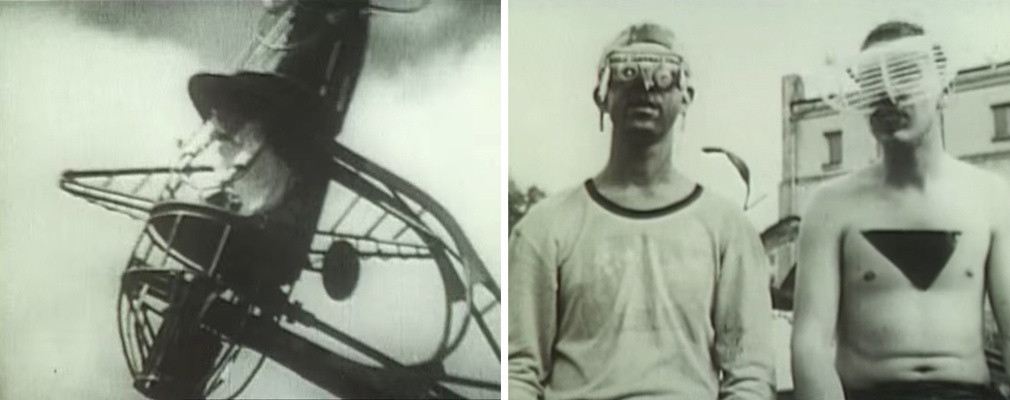
However, the iconoclastic act is “not only the breaking of images…but also the making of new images and new signs out of the ruins.”7 The film is rearing a new Soviet man, it is just that this new man does not pave the way for humanity’s utopian future; instead, he has a giggle with his friend and wears silly glasses. These are the men of the perestroika era, paving the way for future generations. This new Soviet man is not in line with what the official discourse would have him be, as a disunity between these two ‘realities’ becomes increasingly apparent and the cracks in the illusion begin to show.
Yet these fault lines facilitate a rich world of interpretation, “new signs out of the ruins”. How do we interpret the Young Pioneers’ song, which soundtracks the film, about how good it is to live in the Soviet land? There are three ways: the ‘official’ way, which views that life is great in the Soviet Union; the ‘ironic’ way, which views that life is terrible in the Soviet Union; and a third, ‘inverted’ way, which views that life is great in the Soviet Union, because official discourse’s tight grip on ‘reality’ is loosening, and the relative freedoms allowed by perestroika have turned the country into a highly productive space in which films such as this can be made.
A similar productivity is found in the film’s title. “The Revolutionary Sketch“ seemingly brings it in line with official state discourse – at first glance, this could well be a state-approved film. However, once the film is watched, the title is recontextualized, as it becomes an ironic reference to official discourse. But then, the ideas in this film are revolutionary, given their de(con)struction of official discourse. The title indeed enters into this unending and cyclical (revolutionary) dialogue with official discourse.
There is a dissonance within the film between what representations of official discourse proclaim, and what the film’s shifting contexts demonstrate and imply. This is the iconoclasm of this film: not a destructive act (the closest it gets to physical destruction is the reversal of the shots of the Kremlin) but rather debasement through recontextualization. In so doing, this film points towards something far more destructive, a sort of self-de(con)structive potential latent within Soviet discourse. Humor is central to this process, since the injection of a playfulness into the seriousness of official Soviet discourse makes the subversive intentions even more apparent. The directors turn the icons of official discourse on themselves in a move which shows their cannibalistic potential. All that is needed for the inversion of this seemingly impermeable and all-powerful discourse to start to unravel is a contextual shift and a bit of irony.
In his famous analysis of life in the Soviet Union, Kabakov describes ‘the void’: “Every person who lives here lives, whether consciously or not, on two planes: on the plane of his relations with other people and nature, and on the plane of his relations with the void.”8 The Revolutionary Sketch shines a light on the discrepancy between these two “planes”, in much the same way that the form of the picture in Bulatov’s work implies a disunity between official discourse and “nature”. The entire world constructed by official state discourse is a fragile illusion which begins to crumble upon being held up to a mirror.
References
- 1.BAMPFA, Avant-Garde Film: `Red Fish in America’ (1990) http://archive.bampfa.berkeley.edu/film/FN8338 [Accessed on 23 September 2020].
- 2.Ibid.
- 3.Martin Kemp, Christ to Coke: How images become icons (Oxford: Oxford University Press, 2011), p.3.
- 4.Erik Bulatov, Slava KPSS, 1975, oil on canvas. 229.5 229 cm.
- 5.Revolutsionii Etiud, dir. by Igor Aleinikov (1987) [available from: https://www.youtube.com/watch?v=Sq3Kgnjo7zA, accessed on 23 September 2020].
- 6.BAMPFA (1990).
- 7.Rachel Stapleton and Antoniio Viselli, `Introduction: If It’s Broke, Don’t Fix It: The Back-to-Front Logic of Iconoclasm’, in Iconoclasm: The Breaking and Making of Images, ed. by Rachel F. Stapleton Antonio Viselli (McGill-Queen’s University Press, 2019), pp.3-20 (pp.11-12).
- 8.Ilya Kabakov, On the Subject of `The Void’. (2008) http://monumenttotransformation.org/atlas-of-transformation/html/v/void/on-the-subject-of-the-void-ilya-kabakov.html [Accessed 13 October 2020].

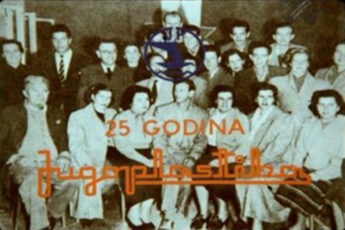
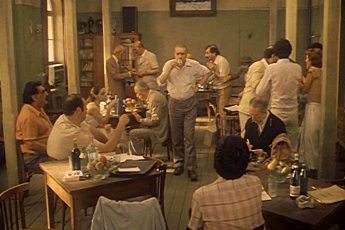
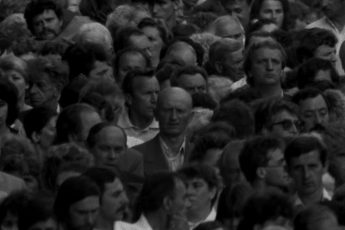
Leave a Comment